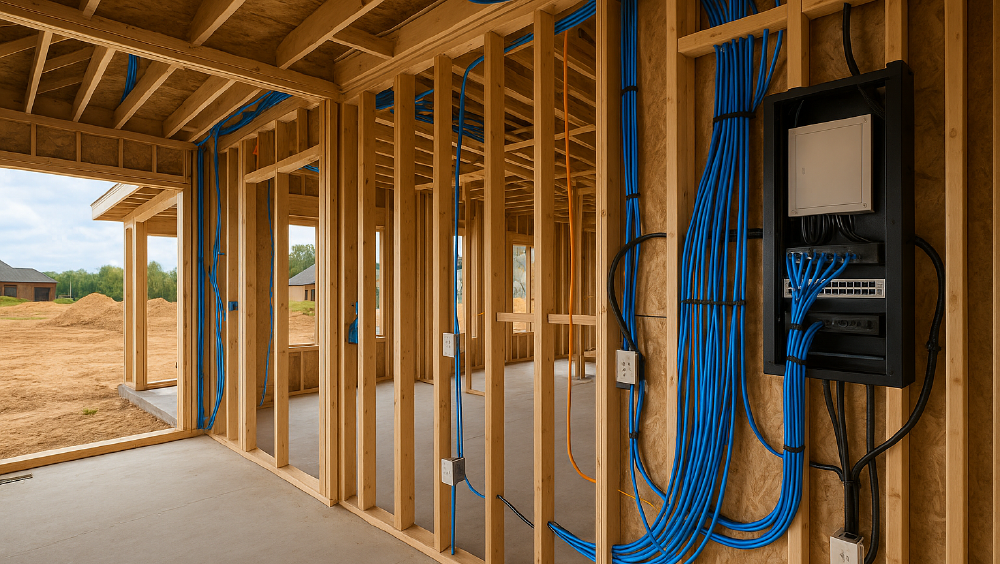Designing for a Connected Future: Practical Insights and Smart Strategies
Why Smart Home Integration Is Now a Design Standard
Not long ago, smart homes sounded like something out of a sci-fi movie—coffee brewing itself, lights adjusting to your mood, and your thermostat knowing you better than your spouse. But today? It’s standard. Especially in the U.S., where tech-savvy homeowners now expect seamless integration of intelligent systems as a basic part of residential design.
As an architect, home builder, or developer, ignoring this shift is like ignoring gravity. Smart Home Integration isn’t a luxury anymore—it’s a baseline expectation. The question is: are you designing with that in mind?
This guide will walk you through practical strategies, foundational knowledge, and Smart Home Integration tips for architects who want to stay relevant, deliver more value, and future-proof their designs.

Smart Home Basics Every Architect Should Understand
What exactly is Smart Home Integration?
Smart Home Integration isn’t just about tossing a few gadgets into a space and calling it “high-tech.” It’s about thoughtfully embedding connected technologies into the design and structure of a home, so systems like lighting, climate, security, and entertainment work together seamlessly—controlled from a smartphone, wall panel, or even a voice assistant.
Think of it like giving your house a nervous system and a brain. It reacts, adapts, and responds to your needs… often before you even press a button.
“Alexa, make this section more engaging.”
You got it—let’s dive into the essentials!
Key Smart Home Systems to Know (And How They Actually Work)
1. Security
We’re not just talking about a doorbell camera. A smart home security system typically includes:
-
- Cameras: These allow homeowners to check live video feeds from anywhere—whether they’re on the couch or on vacation. Some even use AI to detect people vs. pets or package deliveries.
- Motion Sensors: These detect unexpected movement and can trigger alerts or even activate lights and cameras.
- Smart Locks: You can lock or unlock doors from your phone. Some even auto-lock when you leave, or unlock when your phone is nearby. Say goodbye to hiding spare keys under the doormat.
✅ Why it matters for architects: You’ll need to consider camera placement, discreet cabling, and door hardware compatibility during design. This isn’t an afterthought—it’s part of the bones of the home.
2. Climate Control
Gone are the days of a single thermostat trying to manage the entire house.
-
- Smart Thermostats: These learn the homeowners’ habits (like lowering the temp at bedtime or when no one’s home) and adjust automatically. Brands like Nest and Ecobee even provide energy usage reports.
- Zoned Heating & Cooling: Different rooms can be set to different temperatures. That guest room no one uses? It doesn’t need full-time AC.
✅ Architect’s angle: Smart HVAC systems may require multiple sensors, thermostats, and zoning dampers. That means more thoughtful layout and coordination with MEP (mechanical, electrical, plumbing) planning.
3. Lighting
This is where design and tech really dance.
-
- Automated Scenes: One tap can trigger a “Relax” mode—dimming lights in the living room and turning off kitchen lights. Another scene could be “Morning” with warm lights gradually increasing to simulate sunrise.
- Occupancy Sensors: These detect motion and turn lights on or off accordingly—great for hallways, bathrooms, or closets.
- Circadian Lighting: Lights change color temperature throughout the day to match natural light patterns, supporting sleep and wellbeing.
✅ Pro Tip: Architects should plan lighting layouts and switch locations with automation in mind. Forget dozens of wall switches—just a few keypads with scene control can simplify everything.
4. Entertainment
The living room isn’t the only place where tech lives anymore.
-
- Multi-Room Audio: Music in the kitchen, jazz in the bathroom, and a podcast in the bedroom—all at the same time. Controlled from a phone or voice assistant.
- Connected TVs & Media Systems: Smart TVs integrate with lighting and audio systems. For example, dimming the lights and lowering blinds automatically when the movie starts.
✅ For designers: Think about where speakers will go (in-wall or ceiling-mounted?), how to conceal wiring, and how to maintain acoustics without sacrificing style.

Common Protocols and Platforms: Simplifying the Tech Jargon
Let’s demystify the alphabet soup of smart home tech.
1. Matter
This is the new kid on the block, and it’s a game-changer.
-
- Matter is a universal standard that allows smart devices from different brands to communicate with each other.
- It’s backed by Apple, Google, Amazon, and Samsung—which means widespread support.
- For architects, this reduces the chances of systems becoming obsolete or incompatible over time.
✅ Think of it as the universal language for smart homes.
2. KNX
A veteran protocol, especially popular in Europe and large-scale luxury projects.
-
- KNX is wired and highly reliable—used in high-end homes, commercial buildings, and even airports.
- It allows complex automation setups, like integrating HVAC, security, lighting, and blinds into one master system.
- It’s flexible, scalable, and ultra-stable—ideal for clients who want ultimate control.
✅ Architect’s insight: KNX requires early planning and coordination with integrators. Cabling and control panels must be included in early drawings.
3. Zigbee & Z-Wave
These are wireless communication protocols, great for smaller systems or retrofits.
-
- Zigbee and Z-Wave allow devices to “talk” to each other without needing individual Wi-Fi connections.
- Z-Wave has a slightly longer range (about 100 ft indoors), while Zigbee supports more devices in a mesh network.
- Both are low-power and popular in off-the-shelf smart home kits.
✅ For new construction: You’ll likely combine these with wired systems. Keep an eye on signal interference from walls or materials like metal or concrete.
Final Word on the Basics
If you’re thinking, “Whoa, this is a lot,”—you’re absolutely right. But here’s the good news:
👉 You don’t need to be a tech wizard.
You just need to design with intention, collaborate early with integrators, and leave space (literally) for technology to thrive within your architecture.
Think of it as designing the house of the future, today.
Planning from the Ground Up: Infrastructure for A Smart Home Integration
Smart Home Integration tips for architects? Start before the walls go up.
Retrofitting is a pain. Smart Home Integration is always more efficient when it’s part of the design from day one. Here’s what to think about:
Where Do You Place It All?
- Hubs & panels: Consider a dedicated tech closet or low-voltage control center
- Wiring: Plan for structured cabling (Cat6, fiber, speaker wire)
- Power: Every smart device needs a reliable energy source (sometimes battery, often hardwired)
Connectivity Considerations:
- Ensure robust WiFi coverage throughout the property
- Avoid interference by separating power lines from data cables
Think Long-Term:
- Design with scalability in mind—what’s a nice-to-have today could be a must-have in 5 years
- Use modular infrastructure that allows for easy device swap-outs and upgrades
If you’re interested in learning more about smart building strategies and gaining insights into smart home integration tips for architects, we recommend reading the AIA article, “Three winning strategies for smart building design .”

Designing with the End User in Mind: Personalization & UX
You’re not just designing a home; you’re designing an experience.
Know the User
- Family of 5 with toddlers? Focus on security and simplicity.
- Digital nomad couple? Prioritize remote access and workspace automation.
Think in Scenes, Not Devices
Instead of: “There will be a switch here for the living room lights.” Think: “How do we create a ‘Movie Night’ scene with dimmed lights, closed blinds, and surround sound?”
UX Design Tips:
- Avoid overwhelming the user with too many apps
- Recommend centralized interfaces or voice control for ease
- Consider different user levels (e.g., a grandparent vs. a tech-savvy teen)
Great design isn’t about the tech—it’s about how people feel in the space.
Why Architects Should Collaborate with Smart Home Integrators
Architects and tech integrators: The dream team
You bring the vision. They bring the wires. Here’s why collaboration is key:
- Early involvement = fewer redesigns
- Avoid costly mistakes like placing HVAC ducts where ceiling speakers need to go
- Design synergy: Work together on layouts, wall space for touch panels, or hiding sensors in crown molding
Smart Home Integration tips for architects often start with knowing who to call.

Smart Home Integration Tips for Architects: Design by System
Let’s break it down:
1. Lighting
- Use hidden LED strips for clean ambiance
- Add motion sensors for hallways and bathrooms
- Offer scene presets: “Dinner Time,” “Relax,” “Work Mode”
2. Climate Control
- Zoned systems for different floors or rooms
- Window treatments that adjust automatically
- Integrate with solar power systems where possible
3. Entertainment
- Plan pre-wired speaker locations in ceilings/walls
- Include equipment racks in a utility room to keep tech out of sight
4. Security
- Strategic camera placement
- Door/window sensors
- Connected smoke, CO2, and flood detection
Design everything with aesthetic and spatial awareness. Make tech invisible but powerful.
Sustainable Design Meets Smart Tech
Smart design is also green design.
Here’s how Smart Home Integration supports sustainability:
- Energy-efficient lighting that adapts to daylight
- Smart irrigation systems that only water when needed
- Sensors that power down unused rooms
- Climate control automation to avoid over-conditioning
Architects aiming for LEED certification or just wanting to make the planet a solid should absolutely integrate these elements. If you want to learn more about sustainable projects, click here to read our article, “10 Groundbreaking Sustainable Architecture Projects.”
Bonus tips for architects to win projects? Homeowners save on bills. That’s a win-win.
Privacy, Security & Interoperability: What You Can’t Overlook
Your clients trust you to keep them safe—digitally and physically
When designing a smart home, it’s easy to get swept up in the wow factor—voice-activated lighting, automated blinds, climate that adjusts to your schedule. But behind all that convenience lies a critical responsibility: protecting your client’s privacy and security. A smart home isn’t truly “smart” if it leaves the door open—literally or digitally—to cyber threats, data leaks, or unauthorized access. As an architect or developer, your job goes beyond aesthetics and layout. You’re now shaping environments where Wi-Fi replaces keys, and voice assistants never sleep. That means the integrity of the home must include digital safety by design. If users can’t trust the systems they live with every day, the entire experience unravels.
Top concerns:
- Data privacy (especially with always-listening voice assistants)
- Device hacking (baby monitors, garage doors, etc.)
Your role:
- Recommend platforms with end-to-end encryption
- Suggest multi-factor authentication
- Stay current on protocols like Matter that improve cross-device communication and security
If their smart home isn’t secure, it’s not smart. Period.

What’s Next? Future Trends in Smart Home Architecture
Get ready—the smart home of tomorrow is even smarter.
Here’s what’s coming:
- WiFi Sensing: Lights and HVAC that respond to movement without a motion sensor
- AI-Personalized Spaces: Lights and sounds that adapt to mood and health
- Augmented Reality Design: Clients walk through smart features before they’re built
Bonus buzzwords to watch:
- Neural networks
- Predictive automation
- Ambient computing
This is your chance to lead the innovation as an architect, not follow it.
A New Blueprint for Residential Design
Smart Home Integration isn’t an add-on; it’s the new foundation. Clients want homes that work as hard as they do, adapt to their lifestyle, and grow with them.
As an architect or builder, your value increases when you understand how to blend beauty, function, and technology seamlessly.
Bring your smart home design to life — partner with Xpress Rendering for seamless 3D visualization and architectural planning — get your quote here.
From detailed renderings to immersive virtual walkthroughs, we help architects and developers showcase Smart Home Integration like never before.
It’s not about knowing how to code a smart thermostat. It’s about designing a home where every system sings in harmony.
So go ahead—design that connected future. And let’s make smart living, beautiful.


